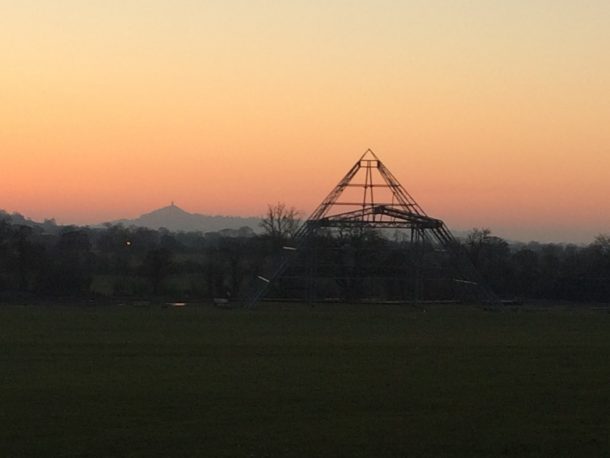Yesterday was the Winter Solstice: the shortest day of the year. We all feel it when the winter nights start drawing in and the days turn cold and grey. The weather changes what we choose to do with our free time, where we choose to go, how we choose to dress.
Our streets change. They are emptier and the pace is faster. Huddled under umbrellas, figures hurry determinedly to their destinations, rather than strolling happily in shorts and sunhats, stopping for chats or lazing in parks.
Individually and collectively, weather influences us deeply yet intangibly. It is an ‘invisible scenography’, which transforms our behaviour and shapes our environment.
But this means that in exactly six months’ time it will be the Summer Solstice, and the Glastonbury Festival will almost be upon us. The effects of weather are heightened at the festival, with 150,000 sharing an outdoor site for four consecutive days. Weather is a central defining factor to anyone’s festival experience. Rain transforms the scenographic landscape, turning grass into mud and spotting the landscape with the festival’s infamous mud baths. Out come the ponchos and the wellies, and the most intrepid among the festivalgoers head out for a splash. Otherwise the rain sends people into tents where they have a drink, listen to a set or have a chat until the downpour passes. Sunshine brings everyone out of their tents to gather in the open air and sit on the grass. With clear weather, festivalgoers also make a pilgrimage in their droves to the Glastonbury Tor, an ancient Pagan site of worship, to watch the sun rise or set.

As outdoor festivals go, Glastonbury is exceptionally sensitive to its natural and meteorological environment. The landscape of the festival site is inextricably linked to Pagan ritual, mythology and leylines, and has fascinated people for generations. As a farm, weather is of central importance to day to day life, to the livelihood of the cattle stock and to the success of the harvests. Michael Eavis, farmer and founder of the Glastonbury Festival, speaks of his relationship with the farm and its natural environment in his BBC ‘Private View’ of the V&A’s Constable exhibition.
This sensitivity translates into festival policy. Michael Eavis has installed the largest privately owned solar PV array in the UK. 1,116 solar panels sit on top of the cattle shed that is home to the 350 Worthy Farm cows. On a clear, sunny day, the panels are generate around 200kW of power – around the same amount used annually by 40 homes. Over the years, the festival has developed its own distinct Green politics, which will be the topic of my next blog post in the New Year.
Of course, weather is also a central consideration when planning the festival’s infrastructure. On a site spanning 900 acres and housing the population of a small city, both sunshine and rain pose their own unique challenges. Even for a festival team as experienced at managing the elements as Glastonbury’s, the weather can still surprise. In 2014, the festival experienced its first ever set delay in history, when an electrical storm forced all the power to be switched off, cutting Rudimental’s set short and delaying Lily Allen’s appearance by half an hour!
***
On 27 May 2015 the V&A’s installation on the Glastonbury Festival will open in Prague, Czech Republic. This will be the V&A’s contribution to the Prague Quadrennial of Performance Design and Space, taking place between 18 and 28 June 2015.


